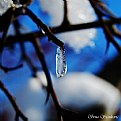| Photography Forum: Darkroom Techniques Forum: |
 |
Q. Masks for burn/dodge

Asked by Christopher Thompson
(K=145) on 4/2/2002
|
I've seen references to people cutting out a mask to fit over a portion of an image to faciliate burning in a specified area in their print. How many folks here do this regularly? When do you find it most useful? Any tips you can offer for using this technique?
|
|
|
|
|
|
|

Bruce Wilson
(K=540) - Comment Date 4/4/2002
|
I've never done it, though I have made shaped dodging tools which I used halfway between the lens and the paper. I guess a mask would work if you moved it around a bit to feather the edges. A mask that would lay on the paper would need some method to registration to make sure the mask lined up exactly on the bright edges, otherwise it would be obvious that a mask was used.
A better method is to make a contrast mask. You need a way to register two pieces of film together, then place your negative over an unexposed film, and expose it partially. When developed, you will get a weak positive of your nagative. When re-registered in the enlarger, the clear areas of the negative will be partially blocked by the mask, lowering the contrast of the image, and bring any very bright or dark areas under control.
If you make the mask with a third piece of clear film bewteen your negative and the unexposed film you will blur the edges of the mask, and make an unsharp mask, which will enhance the egde contrast in the mask.
You can get film registration tools at Porters or B&H.
|
|
|
|

Nigel Smith
(K=3834) - Comment Date 4/4/2002
|
All the time... I have some basic shapes that I use or my hands if I can create a suitable shape with them but usually will make a custom mask out of an old reject print. I never lay the mask on the paper as you'll get visible areas. If the area is quite complicated I will create my mask like this --> Support the paper/cardboard on something solid (books/box) so that it's 1/3 to 1/2 the distance from paper to lens. Refocus image on the paper and draw around the area outline. Cut it out and refocus enlarger on easel. Hold the mask in the light path at the same heigh as you drew it, perfect match! You still need to jiggle it about during the exposure and sometime's I'll stick the mask to a bigger piece of card to ensure it's big enough to stop light on the opposite side to where your burning in. If I'm using a hole to burn in a small section (eg a face) I have a large piece of cardboard that has a good sized hole in it and over that I put another piece of card with an appropiate sized and shape hole to suit the burning in. This also works well for when your working near the edge of a image.
You can buy/make a nifty device that consists of two red plastic discs with several shapes cut into it that can be manipulated into all sorts of shapes, and lets you see the whole image on the easel (the red acts as a safe filter) which can help with accuracy. Another point is to make sure your burns and dodges are long enough that the time you spend locating the right spot doesn't alter the exposure! A foot switch on the enlarger is a good idea (I need one!)
|
|
|
|

Natalie L.
(K=20) - Comment Date 8/12/2002
|
Hi
I don't know if your question was answered, but I've been doing custom printing for a long time and the most useful tool is a home-made one. Use a thin piece of cardboard (about 8x10")with a 1" hole cut in it (a little off-center) then from a separate piece of cardboard, cut a small piece (see attachment) to place over the hole to customize the size and shape of the 1" hole for different needs.
You can place a wide strip of tape around the hole so that each time you reposition the "customizing" piece, it won't rip off layers of the cardboard.
For any burning or dodging, the trick is to keep the tool moving, and to position it no closer to the print than about halfway between the print and the enlarger lens.
If I haven't been clear, or if you have more specific questions, I'd be happy to try and answer. (Hope I managed to do the attachment right)
Natalie
|
|

|
|
|
















